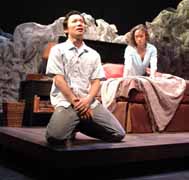
Paulanne Simmons
What They Did for Love
 |
| "The Female Heart" (Photo by Joanne Dugan) |
“The
Female Heart”
Directed by Jamie Richards
The Clurman Theater at Theatre Row
410 West 42nd St. (between 9th and 10th avenues)
Feb. 25 – 26, March 2 – 5, March 9 – 12 at 8 p.m.
Feb. 26 – 27, March 5 – 6, March 12 – 13 at 3 p.m.
Tickets $15, Ticket Central (212) 279-4200 or www.ticketcentral.com
Reviewed by Paulanne Simmons, March 9, 2005
Smokey Mountain, in Manila Philippines, was at one time the world’s biggest garbage dump. It was the home of thousands of squatters who earned their living by picking out of the refuse valuable items they could later sell. In Linda Faigao-Hall’s new play, “The Female Heart,” this huge mound of garbage frames the action both physically (Dan Kucher designed the excellent set) and psychically.
The Female Heart is a Diverse City production, directed by Jamie Richards and playing at The Clurman Theatre at Theatre Row. It tells the bitter story of a Filipino family surviving on Smokey Mountains from 1992 to 2001.
Rosario (Ching Valdes-Aran) is the well-meaning but ineffective mother of a girl, Adelfa (Roan Figueroa) and boy Anghel (Victor Lirio). The two young people will do anything to escape their lives of brutal poverty. Anghel becomes a male prostitute and ends up contracting tuberculosis. Adelfa becomes a mail order bride and ends up in Brooklyn, married to Roger (Tim Davis), a sexual pervert who has anger management problems.
Adelfa endures Roger’s mental and physical abuse because he sends home money to her ailing brother and helpless mother. But after a while, Anghel begins to realize what this money has cost his sister and becomes determined to do something about it.
Anghel’s sacrifice is one that requires virtues Filipinos qualify as “pusong babae” – compassion, humility and gentleness traditionally attributed to women, thus the Female Heart.
Richards has cleverly staged the play so that the audience sees the drama from the eyes of the mother and son who have stayed in Manila and the girl who has moved to Brooklyn. Despite the overwhelming tragedy of their lives, the play is not without humor that reflects the ironies of impoverished people becoming acquainted with American consumerism.
Faigao-Hall has a powerful story to tell. But not having enough faith in her story, or perhaps wanting to give her play more of a didactic nature, she sets the action as a flashback brought on by the Adelfa’s watching a television news broadcast from Manila. This allows her to give the audience quite a bit of information, but it is dramatically unnecessary and distracting.
The Female Heart, however, manages to survive a slow beginning. Figueroa’s acting skills blossom when she is transported to Brooklyn and Lirio becomes more eloquent as he gets sicker. Roger injects bucketfuls of energy into the play with a performance that is fearsomely on target.
The Female Heart will no doubt resonate with the Filipinos who watch it. But there are times when the play does take that giant step beyond the political to the universal. It is at these moments that The Female Heart most successfully touches all of our hearts. [Simmons]

| museums | NYTW mail | recordings | coupons | publications | classified |